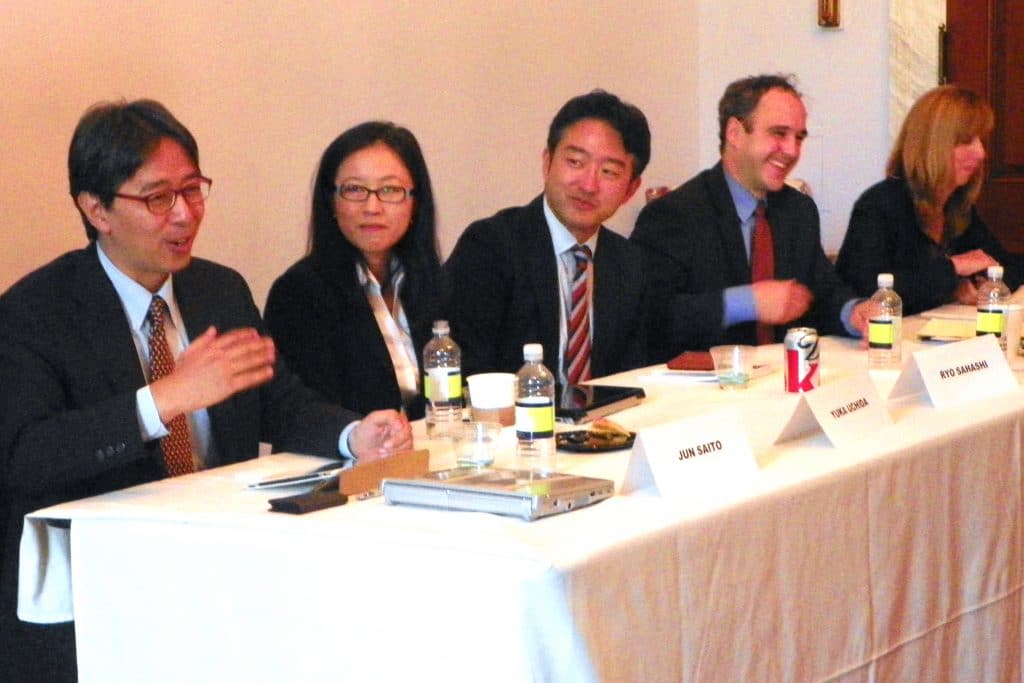As part of JCIE’s project on Political Leadership in Japan, on September 25, 2012, JCIE and the US Association of Former Members of Congress’ Japan Study Group co-hosted a panel discussion for US Congressional staffers and others on the frequent turmoil that has characterized Japanese politics in recent years and made it difficult for Japanese prime ministers to project strong leadership. Jun Saito, Yuka Uchida, and Ryo Sahashi spoke about the range of factors contributing to the heightened political instability, emphasizing the implications for Japan’s relations with the United States, China, and Korea.
Saito, a former Diet member, noted that the fact that Japan has had six prime ministers in six years means that it has had the greatest rate of turnover in prime ministers in the modern history of any advanced democratic country. And many commentators expect yet another new prime minister to come to power after the next general election for the Lower House, which most predict to take place before the yearend. However, Saito argued that Prime Minister Noda is likely to wait until July to call the election, trying to coordinate the timing with the regularly scheduled elections for the Upper House, which will take place in July.
The one development with the greatest probability of derailing an attempt by Prime Minister Noda to delay the election until Summer 2013 would be another mass defection by Democratic Party of Japan (DPJ) members. With the DPJ currently holding a Lower House majority of only nine seats, it will take only ten members leaving the party to allow a no-confidence vote to succeed.
All of the speakers agreed that the Liberal Democratic Party (LDP) is likely to gain the most seats in the next election, but it will need to form a coalition government in order to gain power. This would almost certainly involve the LDP leader being selected as prime minister. (The LDP party elections were held the following day, on September 26, and the hawkish former Prime Minister Shinzo Abe was voted back into power as LDP president.) However, any coalition government to emerge from the new elections is likely to include either mismatched partners or involve untested parties; therefore, the instability in Japanese politics will probably continue for the short term.
In trying to explain Japan’s political instability, foreign analysts have focused a great deal on the personalities of individual politicians and the inexperience of the DPJ after coming to power in 2009. However, Uchida, Saito, and Sahashi argued that there have been fundamental institutional issues that are playing a major role in making Japanese politics more unstable. Saito explained that the 1994 election reforms, which largely corrected malapportionment in the Lower House, have contributed to the instability. The reforms failed to deal with the malapportionment in the Upper House, which heavily favors more conservative rural voters, and this makes divided government in which one party holds a majority in the Upper House and another in the Lower House much more likely than before. A trend, therefore, has developed in which the party controlling the Upper House has given up on pursuing legislative aims and instead uses its veto power to embarrass and topple the prime minister and his party’s control over the Lower House.
Uchida, who was a long time DPJ staffer and a top aide to Foreign Minister Seiji Maehara, noted that a breakdown in party discipline has also played a large role in fueling greater instability. Many politicians in the DPJ have staked out different policy stances more to gain the upper hand in power struggles rather than due to true ideological differences, and similar trends can be seen in the LDP.
Of course, as Sahashi and Uchida pointed out, growing difficulties in implementing policy have also undermined public confidence in the ruling party. As the leading opposition party prior to 2009, the DPJ had several features in place such as a “next cabinet” (a shadow cabinet) to advise on foreign and defense policy issues in order to prepare for its goal of breaking the decades-old LDP dominance of the political system. However, once it was in power, inexperience and political miscalculations led the DPJ to mishandle efforts to implement what were, in reality, bold and innovative reforms. For example, the DPJ attempted to shift policymaking power from ministry bureaucrats to politicians by bypassing traditional policymaking processes, but this alienated the ministry bureaucrats who had the expertise that the DPJ needed to be able to succeed.
Sahashi, an associate professor at Kanagawa University, noted how the instability that has come to characterize Japanese politics has had a negative impact on relations with the United States and Asian countries, even though the US-Japan alliance still remains strong. Given the way that the region is rapidly changing, all three speakers agreed that there is a great need to reexamine and reform various institutional mechanisms in Japanese politics so that Japanese leaders can once again effectively lead and enact the forward-looking policies that Japan needs to tackle its daunting domestic and overseas challenges.
AGENDA
WELCOME
Sabine Schleidt, Director, International Programs, US Association of Former Members of Congress
MODERATOR
James Gannon, Executive Director, JCIE/USA
PRESENTATIONS
Jun Saito, Former Member, House of Representatives of Japan; CEO, Logos Group
Yuka Uchida, Former Political Secretary to the Foreign Minister of Japan; Senior Policy Advisor, Fleishman Hillard Japan
Ryo Sahashi, Research Fellow, JCIE; Associate Professor, Kanagawa University

